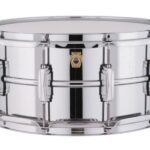When it comes to musical instruments, few can match the uniqueness and appeal of the bandoneon and accordion.

These instruments have a way of appealing to both musicians and audiences worldwide.
And this is not just because of how they look but their unique sounds and remarkable versatility.
In this article, we compare the bandoneon and accordion.
As we do, take note of their origins, construction, musical styles, playing techniques, sound characteristics, and cultural significance.
You will better understand these instruments and perhaps even find yourself drawn to one over the other.
Contents
- 1 Bandoneon vs. Accordion – History and Origins
- 2 Bandoneon vs. Accordion – Instrument Construction
- 3 Bandoneon vs. Accordion – Musical Styles and Genres
- 4 Bandoneon vs. Accordion – Playing Techniques
- 5 Bandoneon vs. Accordion – Sound Characteristics
- 6 Bandoneon vs. Accordion – Cultural Significance
- 7 Wrap Up
Bandoneon vs. Accordion – History and Origins
The bandoneon traces its origins back to the early 19th century and shares a close association with German concertinas.
It was originally discovered in the heart of Argentina and was designed as a portable reed instrument.
It was in the warm melodies and expressive qualities of the bandoneon that tango music found its wings.
The bandoneon later became an integral part of the tango music scene.
On the other hand, the accordion weaves its story through the tapestry of European musical traditions.
Its invention and subsequent evolution spanned several centuries, resulting in a diverse array of regional variations.
The accordion’s remarkable versatility and adaptability have made it popular music across the globe.
Bandoneon vs. Accordion – Instrument Construction
The construction of these instruments is a marvel in itself. The bandoneon stands as a testament to craftsmanship.
It has a square-shaped body and buttons that adorn both sides. Its reeds come alive when air is drawn in or expelled from its bellows, producing a rich and captivating sound.
The layout and construction of the bandoneon make it a truly unique instrument. Why is that?
Because it allows for intricate melodic and harmonic possibilities that can transport listeners to new emotional depths.
In contrast, the accordion has a rectangular shape. It is accompanied by a piano-style keyboard on one side and bass buttons or a piano keyboard on the other.
Similar to the bandoneon, the accordion employs reeds that come to life through the motion of its bellows.
However, the accordion’s construction varies depending on its type, be it a piano accordion, chromatic accordion, or diatonic accordion.
This results in variations in range and capabilities across different models.
Bandoneon vs. Accordion – Musical Styles and Genres

Now let’s explore the musical worlds in which these instruments thrive. The bandoneon occupies a special place within the world of tango music.
Its melancholic timbre and expressive qualities perfectly capture the nuanced emotions that define this passionate genre.
Legendary tango musicians like Astor Piazzolla showcased the bandoneon’s immense capabilities.
Performances pushed its boundaries and elevated its status as both a solo and ensemble instrument.
Beyond tango, the bandoneon has ventured into other music genres. Examples include contemporary classical music, jazz, and even experimental genres.
What about the accordion? It features a vast array of styles and regional variations that embraces a wide range of musical genres.
The accordion has left a permanent mark in folk, traditional, and popular music scenes across the globe.
Its influence extends to genres such as Zydeco, Cajun, Tex-Mex, and even rock and pop music.
Its distinctive voice adds a flavorful and unmistakable texture to the overall sonic landscape.
Bandoneon vs. Accordion – Playing Techniques
Mastering the art of playing both the bandoneon and the accordion requires a deep understanding of their unique techniques.
And that can take years of practice and exploration. Playing both instruments also requires intricate control of their bellows.
When it comes to the bandoneon, musicians must navigate a world of complex fingerings (use of the fingers).
Musicians also need to learn various articulations such as legato, staccato, and accents to convey the desired expressiveness.
The bandoneon’s buttons offer musicians precise control over melody, harmonies, and chords.
Getting this right will help them to craft intricate and emotionally charged musical landscapes. What does it take to play the accordion?
The piano accordion technique involves playing melodies and chords on the keyboard side.
The left-hand side controls the bass accompaniment using buttons or piano keys simultaneously.
Additionally, the Stradella bass system, commonly found in many accordions, provides preset chords that enhance the instrument’s versatility.
Different playing techniques come into play depending on the musical genre. This enables musicians to create rich and harmonically textured arrangements.
Bandoneon vs. Accordion – Sound Characteristics

One cannot help but be amazed by the remarkable sound characteristics of both instruments.
The bandoneon has this unique tonal quality that sets it apart from other instruments. Its reeds produce a warm and intimate sound that resonates with good sound quality.
The bandoneon’s sound becomes synonymous with longing, nostalgia, and the profound emotional depth that defines the genre.
On the other hand, the accordion boasts a reputation for its versatility and expansive sound palette.
It has a combination of multiple reeds, register switches, and tone control options. This allows for a wide range of timbres and dynamics.
From the bright and vibrant to the soft and mellow, the accordion adapts effortlessly to various musical contexts.
Bandoneon vs. Accordion – Cultural Significance
Beyond their sonic marvels, these instruments hold profound cultural significance.
The bandoneon stands as a symbol deeply woven into the history and identity of Argentina.
It has become an emblematic instrument of tango music, which permeates every aspect of Argentine culture.
The accordion similarly holds regional significance in diverse cultures around the world.
It is evident in the infectious rhythms of Colombian vallenato and the lively tunes of Irish traditional music. The accordion is truly an embodiment of cultural identity.
It is often associated with festivities, celebrations, and communal gatherings.
Wrap Up
Both instruments offer a unique and captivating musical journey.
It doesn’t matter whether you find yourself drawn to the bandoneon’s soulful melodies or captivated by the accordion’s vibrant energy.
So, let the bandoneon and accordion be your guides. Let them transport you to the depths of emotion and celebration that only musical marvels can provide.






